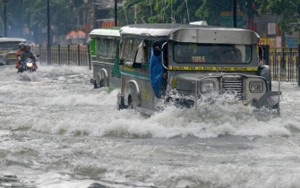SAN Pablo City, touted as the “jeepney capital of the Philippines,” experienced a financial crunch in 2012 as it posted debts amounting to P226 million.
In the latest report of the Commission on Audit (COA) on the financial health of the prime city in the province of Laguna, state auditors bared that the cash intact in the city coffers, which amounts to P18.5 million, was not able to cover its total liabilities worth P226.4 million.
Tagged as the “jeepney capital” of the country, San Pablo City contributed much to the country’s transportation industry. Large number of various passenger jeepneys, owner-type jeeps, Asian utility vehicles and mini-buses are assembled annually in the city.
Despite this, the cash deficit of the city already registered at P207.8 million compared with the previous year’s P119.2 million.
“The City of San Pablo was not able to reduce or eliminate the insufficiency of cash incurred in the previous years, hence, the cash available is still insufficient,” the audit team noted.
In total, the city only had P6.7 million in its General Fund, P9.6 million in its Special Education Fund and P2.1 million in its Trust Fund.
This is in stark contrast to its standing liabilities now at P226.4 million: P198.8 million in the General Fund, P11.5 million in the Special Education Fund and P16 million in the Trust Fund.
Less P18.5 million, the city’s cash insufficiency stands at P207.8 million.
“The city failed to reduce or eliminate the incurrence of cash overdraft. Instead, the cash insufficiency increased by 74 percent,” state accountants reported.
COA observed that the city experienced delay in remitting and paying various obligations to different government agencies “which may affect the entitlement of benefits of officials and employees.”
Lack of funds would also hamper San Pablo’s capacity to pay its present obligations “since current collections will be used to pay prior year’s obligation.” This would affect the cash availability for the succeeding year.
Only 8 percent
Due to unavailability of funds, the city implemented only 12 projects out of the 144 lined-up for the year, or only 8 percent.
“This deprived the city’s constituents of the benefits they could have enjoyed from the payment of their taxes through development projects and programs,” COA said.
Among the delayed projects were: construction, repair or renovation of school buildings, multi-purpose buildings and barangay (village) halls, line canals, roads; agricultural productivity enhancement program; construction of a water reservoir and water system; and rural poverty alleviation program.
COA said that this might result in the slow progress of the city which may further drag the city’s classification compared with neighboring municipalities and cities from within Laguna.
Low generation of income “causes negative impact” on the city’s efficiency of work in providing benefits to its constituents, auditors said.
Review of the 2012 financial statements of the city showed that San Pablo incurred expenses in the amount of P732.5 million, way above the total collected income amounting to P716.3 million.
Expenses in the amount of P68.4 million at the time of the effectivity of the 1992 Tax Code is only nine percent of the expenses for 2012.
“In effect, the tax rates provided in the 1992 Tax Code were no longer just and reasonable to the present economic condition and relatively affects the financial capability of the city,” COA said.
Auditors noted that low generation of income was due to the city’s failure to collect delinquent taxes on real property and business establishments.
They urged the city officials to revise already the stale 1992 City Tax Code to generate more sources of income.
In response, the city officials already informed COA that the provincial council finally approved and enacted the 2012 Revised Revenue Code on March 13, 2012.
“It is expected that the new revenue code will generate an increase of 20 to 25 percent to the city’s collection,” they said.


